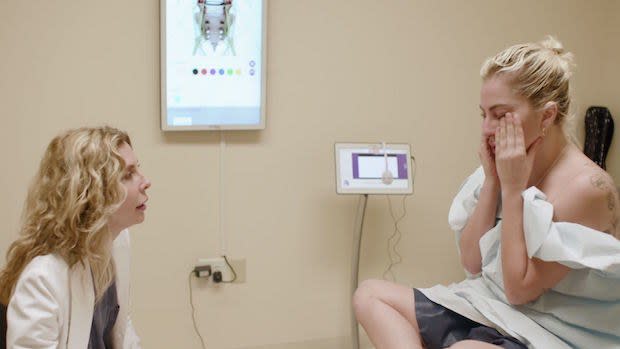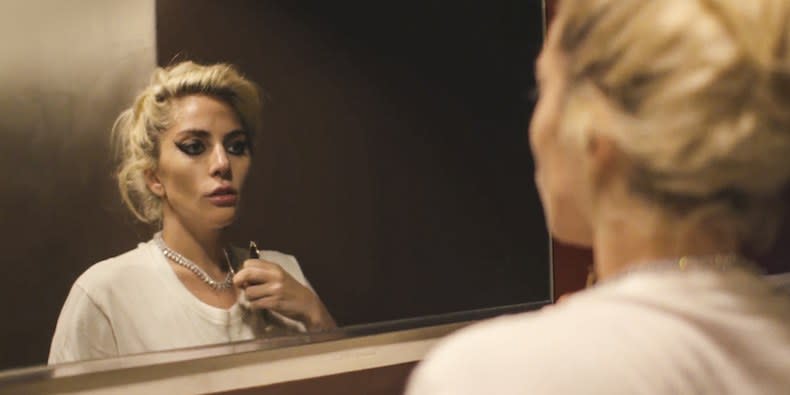Netflix’s New Lady Gaga Documentary Finally Lets the Real Stefani Germanotta Speak
Lady Gaga used to wear impossibly high heels. In the music video for “Bad Romance,” she famously crept across an empty room in a pair of ten-inch Alexander McQueen “Armadillo” stilettos. “I dress like this all the time,” she’d told a reporter, early in her career. “You’re never gonna catch me at the grocery store in flip-flops.” Even daytime talk shows merited high-concept outfits with outrageous footwear to match. On “The View” in 2011, she wore 18-inch platforms.
Six years later, her new Netflix documentary is called Gaga: Five Foot Two, and, true to its title, the film finds her several inches closer to earth. In an early scene, Gaga appears at home in a gray bodysuit, baggy sweatpants, and sneakers. Her bleached hair spills out of a loose bun, dark roots framing her face. As she pushes food around in a pan, Gaga reveals that she’s fighting with her fiancé, Taylor Kinney. (The couple eventually split.) “I’m in a different place in my life right now,” she tells the camera. “My threshold for, like, bullshit with men is… I just don’t have one anymore.”
All pop-star documentaries whose subjects get a producer credit—which is to say, just about all pop-star documentaries in the 21st century, including Five Foot Two—are works of propaganda. Beyoncé’s HBO doc Life Is But a Dream presents an attractive, superficial portrait of a perfectionist. Justin Bieber’s 3D concert films, Never Say Never and Believe, frame him as a normal kid who’s crazy about his fans. In The 1989 World Tour, Taylor Swift shares the stage with a parade of famous entertainers, as if to prove that all of those people really, truly like her.
Compared with these nakedly promotional spectacles, Five Foot Two feels intriguingly raw. Directed by Chris Moukarbel, who has also profiled Banksy and viral sensation Chris Crocker, the film is a vérité-style chronicle of Gaga’s life as she recorded, released, and promoted last year’s Joanne, culminating with her Super Bowl Halftime Show performance in February. There are a few glamorous moments—she plays a stripped-down rendition of “Bad Romance” at Tony Bennett’s 90th birthday gala, and she gathers an enormous crowd of fans in the desert for her “Perfect Illusion” video. Performance footage is sparse. More often, we see Gaga working obsessively, hanging out with friends and family, and managing pain both physical and emotional. Five Foot Two is (among other things) a commercial, but it’s a commercial for Stefani Germanotta, the real person Lady Gaga spent nearly a decade hiding from public view.
The film is a logical extension of Joanne, which Gaga named after an artistic aunt who died of lupus before she was born. In a departure from her three previous solo albums (and her 2014 detour into standards alongside Bennett), Gaga largely ditched dance-pop in favor of country-tinged power ballads. In public appearances, she dressed the way Bruce Springsteen might if he were contractually obligated to show some skin, in cropped T-shirts and tiny denim cutoffs with bandannas stuffed in the back pockets. Her Americana chic extended to a dive-bar tour sponsored by Bud Light and a track called “John Wayne” that celebrates its subject as “blue collar and a red-state treasure.” After the Koonsian disappointment of her 2013 album ARTPOP, Joanne looked like an attempt to reintroduce Gaga as a relatable heartland gal who lusted over cowboys and drowned her sorrows over Pinot Grigio with her girlfriends.
Moukarbel’s portrait of the real Stefani is comparatively light on Americana kitsch—which makes sense, considering that she was born into a well-off family, raised in Manhattan, and has about as much in common with Middle American moms as she does with fantastical fame monsters. Instead, we get carefully measured, but often fascinating, snapshots of life as a 30-year-old star who wants to stop hiding behind the outsized persona she crafted a decade ago.
Gaga has said that she only asked Moukarbel to turn off his camera a few times during production, and although that doesn’t account for everything that must have gotten cut in editing, there are some open inclusions. We watch her lament the way her all-consuming career sabotages her romances, but she still makes time to keeps tabs on her friend and collaborator, Sonja Durham, who died of cancer this spring. Her chronic pain condition flares up, and she allows viewers to see her writhing on a couch, wondering aloud, “Do I look pathetic?” There’s a lot of crying, none of it melodramatic.

As an artist, Gaga is revealed to be just as tireless and exacting as she’s always seemed. Her relationship with collaborator Mark Ronson, whom she praises for being more respectful than other male producers, is warm and honest. They celebrate successful sessions and have productive arguments. She cries on his shoulder when she’s worked herself ragged. On the set of “American Horror Story,” whose cast she joined for seasons five and six, and in rehearsals for her Super Bowl set, she has minor breakdowns when decisions are made without her input, but quickly regains her composure. Before greeting her fans at the “Perfect Illusion” shoot, she frets that they’ll be disappointed to see her without all the makeup and glitter.
Her self-awareness is endearing. “I want to do the opposite of what everyone thinks I’m going to do,” she announces in a meeting about the halftime show. “Everybody thinks I’m gonna come out on a fuckin’ throne, in a meat dress, with 90 shirtless men and unicorns.” Later, she shrugs off the inevitable analyses of the performance: “Everyone’s gonna read into it what they want to read into it. That’s the way this goes.” Particularly for an artist who made her name dramatizing the ravages of fame, that’s a surprisingly healthy attitude towards public scrutiny.
The film isn’t entirely free of contrived scenes. A lightly disguised Gaga makes a big show of buying Joanne at a Walmart. Moukarbel includes a conversation that seems calculated to generate headlines, where she vents about the way Madonna trashed her in the press: “The only thing that really bothers me about her is that I’m Italian and from New York, you know? So, like, if I’ve got a problem with somebody, I’m gonna fuckin’ tell you to your face… Telling me you think I’m a piece of shit through the media—it’s like a guy passing me a note through his friend: ‘My buddy thinks you’re hot.’” Is it more mature to talk shit in a documentary you produced?
These false notes aside, the film accomplishes what Joanne couldn’t: It peels away even the new, “authentic” persona to give us a glimpse of what remains when Stefani Germanotta steps out of her Lady Gaga drag. She appears to be a smart, funny, sincere, and hard-working woman, as well as the same kind of anxiety-ridden control freak some of us will recognize from our own bathroom mirrors. Many of her fans miss the old, weird Gaga, clad in 18-inch platforms. I do, too. But if Stefani is here to stay, she might consider letting the person we meet in Five Foot Two sing on her next album.
“Gaga: Five Foot Two” streams on Netflix starting this Friday, September 22.

